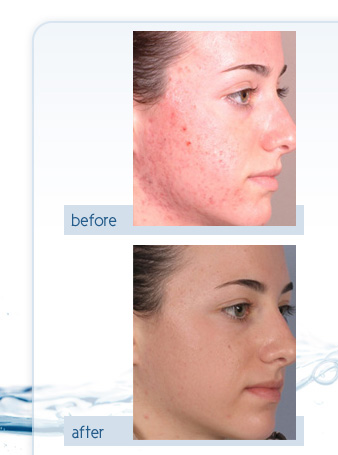

Causes: Hyperkeratinization (accumulation of dead skin cells) and formation of a plug of keratin and sebum (comedon) around the hair follicle and its associated sebaceous gland may set the disease in motion. Usually, bacteria would set in the pores making it more severe acne (inflammatory), but acne can also be non-inflammatory.
Standard Treatments: You should see a dermatologist or a skin specialist
for any case of mild to severe acne. Medications vary, based on the causes
and the severity of the Acne. Some of the most commonly used would be
(a) Topical retinoids (Retin-A), related to vitamin A, are administered
as topicals and help prevent the hyperkeratinization of these cells that
can create a blockage. (b) Oral retinoids ( Accutane) oral intake of
vitamin A derivative administered over a period of 4-6 months has been
shown to be very effective in treating severe acne. The treatment requires
close medical supervision by a dermatologist and DermoLissage (or any
procedure that peels, disturbs the upper-skin structures and exfoliates
the skin) is not to be started when Accutane is taken and for a longer
period of many months afterwards (and by physician recommendation only;
(c) Phototherapy ('Blue' and red light) and Photodynamic therapy (PDT)
intense violet light, on pretreated skin with ALA, as well as light sources
as LED, lasers may also be effective, in particular if used
in combination with the clean exfoliating, anti-bacterial and anti inflammatory
effects of the DermoLissage technology.
DERMOLISSAGE FOR TREATING ACNE
* DermoLissage can dramatically improve Acne by multiple means, each to address a specific cause, and when all combined it bring the most amazing outcomes. DermoLissage initially is acting as a "clean and safe superficial mechanical abrader" to exfoliate the Hyperkeratinization (accumulation of the dead skin cells on top layer of the dermis), then and simultaneously, it infuses Salicylic Acid which kills the bacteria and also helps in further exfoliation, then, and to finalize treatment - one can hydrate the deep layers of the dermis with a last pass of the hydrating solution, since Acneic skin is most times very dry (still can be oily). Even pustular acne, at the time of worst breakouts may benefit tremendously from the DermoLissage treatment, and moving the handpiece on top of the pustules does not cause infection thanks to the anti bacterial benefits of the Salicylic acid. If in doubt, consult with your dermatologist before treatment.
* The appropriate topical solution: Clarifying solution with Salicylic acid. Salicylic Acid, a natural active extract of the willow bark, has anti-inflammatory and antiseptic benefits, it exfoliates surface cell buildup. Key ingredient in many skin-care products for the treatment of acne, psoriasis and more callous skin conditions. It works by causing the cells of the epidermis to slough off more readily, preventing pores from clogging up, and allowing room for new cell growth. Salicylic Acid is not to be used in people allergic to aspirin, some are hypersensitive to salicylic acid and related compounds. Best results if combined with deep hydration of the dry acneic skin (1 additional pass with skin specific Hydrating solution with Hyaluronic acid) , the acne lesions start diminishing and skin getting healthier, and looking better from the 2nd session.
* Number of Sessions: usually 6-12 procedures; 2 per week for 2 weeks, and then weekly.
* Results - conditions usually would improve a couple of days after the first session, and further sessions keep the skin healing and returning to normal. It may look worse (reddish pimples), for a couple of days, until it looks better, but ultimately, the skin "rests" and the anti-inflammatory and therapeutic effects kick in and the skin looks much better and the pimples disappear.
* After a couple of sessions the Acne inflammation is visibly reduced, condition of the pimples substantially improved, skin is beautifully reconditioned. Procedure recommended even for pustular acne (the acute form), and as effective for chest, back, shoulders and other parts of the body.